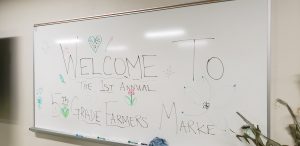By Jeremiah Eaton
To many people, the term “sustainability” is little more than an overused buzzword in political discourse and public policy. The term doesn’t resonate with the public like it should. I believe this is due to a lack of understanding of what sustainability actually represents. First, I would like to establish a clear definition of the term. Sustainability is defined as a long term goal that is built on the practice of sustainable development. The Brundtland Commission, an organization seeking sustainable world development, released a groundbreaking report in 1987 that defined sustainable development as “development that meets the needs of the present without compromising the ability of future generations to meet their own needs.” This definition clearly shows that sustainability is not just a buzzword, but rather an ideal that we should build our systems upon. Sustainable systems aren’t built on harsh restrictions, lack of progress, and profit losses. Rather, they are founded on innovation, development, and economic stability. Sustainable development represents a better future, the highest common interest of all people living in our society. Striving for sustainable systems should be the goal of all goals, to leave the next generations the best world possible while still fulfilling our current needs.
It is important to note that sustainability is built on a foundation of three pillars: social, environmental, and economic. These pillars are often referred to as people, planet, and profit. A system must be built in compliance with all three pillars for it to be deemed sustainable. These pillars ensure properly constructed systems are socially viable, environmentally conscious, and financially stable. As you can imagine, this is not easy to achieve. Building a sustainable future requires forward thinking and continuous adaptation. Currently, our most successful systems are built on the pillars of sustainability, yet we fail to recognize this. We need to realize that the ideals of sustainability are vital to the systems that we, as a society, cherish. Sustainability needs to become a large part of the conversation as we prepare for the future, but the term needs to be completely transparent and collectively understood. We can only move forward with sustainability if we, as a society, recognize its inherent value and translate recognition into action. That is one of my main aspirations in my service position with Energy Corps here at Glacier National Park.
The National Park Service is an excellent example of a sustainable system. In fact, the definition of sustainability and NPS’s mission statement are strikingly similar. The NPS mission statement states that they “conserve unimpaired the natural and cultural resources and values of the National Park System for the enjoyment, education, and inspiration of this and future generations.” This statement directly incorporates two of the three pillars of sustainability: environmental and social. The third pillar, economic, is of course supported by our society through taxes and annual visitations. Their mission statement also addresses the overarching goal of sustainability, to pass on the best possible world to future generations while still allowing us to enjoy it in the present. According to the National Park system’s total annual visitation numbers (330 million), it appears that people value what sustainable systems can offer. Let us recognize that many of the institutions we value are the result of well-founded goals and well-constructed systems. Sustainability is beneficial to everyone, and that is clear here at Glacier. If we like the results of sustainable systems, then we should direct our effort into creating more of them. That process starts with conceptually understanding what sustainability is and making it a goal for the systems we work within.
I am working to redefine what sustainability means to the people in my community. I was recently interviewed by the local radio station to discuss what sustainability actually means to Glacier National Park and our extended community. They asked a myriad of questions that helped lend them a better understanding of what we are trying to do, and how we do it. Sustainability needs to overcome its current perception of a vague and overused buzzword. Sustainability needs to be clearly understood and adopted as a central tenet of our society. Our society is excellent at stepping up to the plate when needed, and now is the time. We need collective effort to change our societal values to incorporate the values of sustainability. As I have stated before, it is imperative that we all develop an understanding of sustainability. Congratulations, you already completed your first step in the process of creating a sustainable future. The next step is to translate your understanding into action. What better time than now? What better place than where you are? Who better than you?
Action Items:
- Purchase sustainable products and services
- Eat local. Know where your food comes from
- Volunteer in your community
- Educate yourself and others
- Make your voice heard








